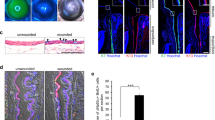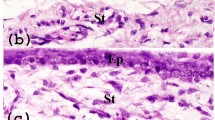Abstract
The integrity of the cornea, the most anterior part of the eye, is indispensable for vision. Forty-five million individuals worldwide are bilaterally blind and another 135 million have severely impaired vision in both eyes because of loss of corneal transparency1; treatments range from local medications to corneal transplants, and more recently to stem cell therapy2. The corneal epithelium is a squamous epithelium that is constantly renewing, with a vertical turnover of 7 to 14 days in many mammals3. Identification of slow cycling cells (label-retaining cells) in the limbus of the mouse has led to the notion that the limbus is the niche for the stem cells responsible for the long-term renewal of the cornea4; hence, the corneal epithelium is supposedly renewed by cells generated at and migrating from the limbus, in marked opposition to other squamous epithelia in which each resident stem cell has in charge a limited area of epithelium5,6. Here we show that the corneal epithelium of the mouse can be serially transplanted, is self-maintained and contains oligopotent stem cells with the capacity to generate goblet cells if provided with a conjunctival environment. Furthermore, the entire ocular surface of the pig, including the cornea, contains oligopotent stem cells (holoclones)7,8 with the capacity to generate individual colonies of corneal and conjunctival cells. Therefore, the limbus is not the only niche for corneal stem cells and corneal renewal is not different from other squamous epithelia. We propose a model that unifies our observations with the literature and explains why the limbal region is enriched in stem cells.
This is a preview of subscription content, access via your institution
Access options
Subscribe to this journal
Receive 51 print issues and online access
$199.00 per year
only $3.90 per issue
Buy this article
- Purchase on Springer Link
- Instant access to full article PDF
Prices may be subject to local taxes which are calculated during checkout




Similar content being viewed by others
References
Whitcher, J. P., Srinivasan, M. & Upadhyay, M. P. Corneal blindness: a global perspective. Bull. World Health Organ. 79, 214–221 (2001)
Pellegrini, G. et al. Long-term restoration of damaged corneal surfaces with autologous cultivated corneal epithelium. Lancet 349, 990–993 (1997)
Haddad, A. Renewal of the rabbit corneal epithelium as investigated by autoradiography after intravitreal injection of 3H-thymidine. Cornea 19, 378–383 (2000)
Cotsarelis, G., Cheng, S. Z., Dong, G., Sun, T. T. & Lavker, R. M. Existence of slow-cycling limbal epithelial basal cells that can be preferentially stimulated to proliferate: implications on epithelial stem cells. Cell 57, 201–209 (1989)
Jones, P. H., Simons, B. D. & Watt, F. M. Sic transit gloria: farewell to the epidermal transit amplifying cell? Cell Stem Cell 1, 371–381 (2007)
Clayton, E. et al. A single type of progenitor cell maintains normal epidermis. Nature 446, 185–189 (2007)
Barrandon, Y. & Green, H. Three clonal types of keratinocyte with different capacities for multiplication. Proc. Natl Acad. Sci. USA 84, 2302–2306 (1987)
Pellegrini, G. et al. Location and clonal analysis of stem cells and their differentiated progeny in the human ocular surface. J. Cell Biol. 145, 769–782 (1999)
Puangsricharern, V. & Tseng, S. C. Cytologic evidence of corneal diseases with limbal stem cell deficiency. Ophthalmology 102, 1476–1485 (1995)
Buck, R. C. Cell migration in repair of mouse corneal epithelium. Invest. Ophthalmol. Vis. Sci. 18, 767–784 (1979)
Potten, C. S., Schofield, R. & Lajtha, L. G. A comparison of cell replacement in bone marrow, testis and three regions of surface epithelium. Biochim. Biophys. Acta 560, 281–299 (1979)
Claudinot, S., Nicolas, M., Oshima, H., Rochat, A. & Barrandon, Y. Long-term renewal of hair follicles from clonogenic multipotent stem cells. Proc. Natl Acad. Sci. USA 102, 14677–14682 (2005)
Kiel, M. J. et al. Haematopoietic stem cells do not asymmetrically segregate chromosomes or retain BrdU. Nature 449, 238–242 (2007)
Barker, N. et al. Identification of stem cells in small intestine and colon by marker gene Lgr5 . Nature 449, 1003–1007 (2007)
Rama, P. et al. Autologous fibrin-cultured limbal stem cells permanently restore the corneal surface of patients with total limbal stem cell deficiency. Transplantation 72, 1478–1485 (2001)
Ronfard, V., Rives, J. M., Neveux, Y., Carsin, H. & Barrandon, Y. Long-term regeneration of human epidermis on third degree burns transplanted with autologous cultured epithelium grown on a fibrin matrix. Transplantation 70, 1588–1598 (2000)
Rochat, A., Kobayashi, K. & Barrandon, Y. Location of stem cells of human hair follicles by clonal analysis. Cell 76, 1063–1073 (1994)
Merkle, F. T., Tramontin, A. D., Garcia-Verdugo, J. M. & Alvarez-Buylla, A. Radial glia give rise to adult neural stem cells in the subventricular zone. Proc. Natl Acad. Sci. USA 101, 17528–17532 (2004)
Shapiro, M. S., Friend, J. & Thoft, R. A. Corneal re-epithelialization from the conjunctiva. Invest. Ophthalmol. Vis. Sci. 21, 135–142 (1981)
Thoft, R. A. Keratoepithelioplasty. Am. J. Ophthalmol. 97, 1–6 (1984)
Tanioka, H. et al. Establishment of a cultivated human conjunctival epithelium as an alternative tissue source for autologous corneal epithelial transplantation. Invest. Ophthalmol. Vis. Sci. 47, 3820–3827 (2006)
Ferraris, C., Chevalier, G., Favier, B., Jahoda, C. A. & Dhouailly, D. Adult corneal epithelium basal cells possess the capacity to activate epidermal, pilosebaceous and sweat gland genetic programs in response to embryonic dermal stimuli. Development 127, 5487–5495 (2000)
Vauclair, S. et al. Corneal epithelial cell fate is maintained during repair by Notch1 signaling via the regulation of vitamin A metabolism. Dev. Cell 13, 242–253 (2007)
Kawasaki, S. et al. Clusters of corneal epithelial cells reside ectopically in human conjunctival epithelium. Invest. Ophthalmol. Vis. Sci. 47, 1359–1367 (2006)
Di Iorio, E. et al. Isoforms of ΔNp63 and the migration of ocular limbal cells in human corneal regeneration. Proc. Natl Acad. Sci. USA 102, 9523–9528 (2005)
Barbaro, V. et al. C/EBPΔ regulates cell cycle and self-renewal of human limbal stem cells. J. Cell Biol. 177, 1037–1049 (2007)
Nakamura, T., Inatomi, T., Sotozono, C., Koizumi, N. & Kinoshita, S. Successful primary culture and autologous transplantation of corneal limbal epithelial cells from minimal biopsy for unilateral severe ocular surface disease. Acta Ophthalmol. Scand. 82, 468–471 (2004)
Oshima, H., Rochat, A., Kedzia, C., Kobayashi, K. & Barrandon, Y. Morphogenesis and renewal of hair follicles from adult multipotent stem cells. Cell 104, 233–245 (2001)
Pellegrini, G. et al. p63 identifies keratinocyte stem cells. Proc. Natl Acad. Sci. USA 98, 3156–3161 (2001)
Schermer, A., Galvin, S. & Sun, T. T. Differentiation-related expression of a major 64K corneal keratin in vivo and in culture suggests limbal location of corneal epithelial stem cells. J. Cell Biol. 103, 49–62 (1986)
Friedrich, G. & Soriano, P. Promoter traps in embryonic stem cells: a genetic screen to identify and mutate developmental genes in mice. Genes Dev. 5, 1513–1523 (1991)
Hadjantonakis, A. K., Gertsenstein, M., Ikawa, M., Okabe, M. & Nagy, A. Generating green fluorescent mice by germline transmission of green fluorescent ES cells. Mech. Dev. 76, 79–90 (1998)
Barrandon, Y. & Green, H. Cell size as a determinant of the clone-forming ability of human keratinocytes. Proc. Natl Acad. Sci. USA 82, 5390–5394 (1985)
Smyth, G. K. Linear models and empirical bayes methods for assessing differential expression in microarray experiments. Stat. Appl. Genet. Mol. Biol. 3, article–3 (2004)
Hochberg, Y. & Benjamini, Y. More powerful procedures for multiple significance testing. Stat. Med. 9, 811–818 (1990)
Acknowledgements
We are grateful to F. Radtke and S. Vauclair for Notch1lox/lox K14Cre ROSA26R mice, to A. Smith for critical reading of the manuscript, to T. Hoang-Xuan, L. Zografos, F. Munier and S. Kinoshita for continuous support and to L. Schnell, J. Vannod and S. Vermot for excellent technical help. The work was supported by grants to Y.B. from the Swiss National Science Foundation (grant 3100A0-104160), the EPFL, the CHUV and EuroStemCell. The early part of the work was supported by grants to Y.B. from the Institut National de la Santé et de la Recherche Médicale (INSERM), the Association pour la Recherche contre le Cancer and the Association Française contre les Myopathies. F.M. was supported by fellowships from the Fédération des Aveugles et Handicapés Visuels de France, the INSERM and then the CHUV.
Author Contributions F.M., A.R. and M.N. performed and assisted in the design of the experiments and the interpretation of results, A.R. and G.A.J. made the figures and G.A.J. and Y.B. contributed the new concept. Y.B. designed the experiments and wrote the paper.
Author information
Authors and Affiliations
Corresponding author
Supplementary information
Supplementary Information
This file contains Supplementary Methods, Supplementary References and Supplementary Figures 1-3 (PDF 4437 kb)
Rights and permissions
About this article
Cite this article
Majo, F., Rochat, A., Nicolas, M. et al. Oligopotent stem cells are distributed throughout the mammalian ocular surface. Nature 456, 250–254 (2008). https://doi.org/10.1038/nature07406
Received:
Accepted:
Published:
Issue Date:
DOI: https://doi.org/10.1038/nature07406
This article is cited by
-
Animal Models for Limbal Stem Cell Deficiency: A Critical Narrative Literature Review
Ophthalmology and Therapy (2024)
-
Phytoconstituents for Boosting the Stem Cells Used in Regenerative Medicine
Current Pharmacology Reports (2023)
-
The common YAP activation mediates corneal epithelial regeneration and repair with different-sized wounds
npj Regenerative Medicine (2021)
-
Animal model with structural similarity to human corneal collagen fibrillar arrangement
Anatomical Science International (2021)
-
Preclinical Studies and Clinical Prospects of Wharton’s Jelly-Derived MSC for Treatment of Acute Radiation Syndrome
Current Stem Cell Reports (2021)
Comments
By submitting a comment you agree to abide by our Terms and Community Guidelines. If you find something abusive or that does not comply with our terms or guidelines please flag it as inappropriate.



